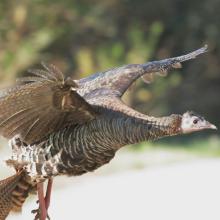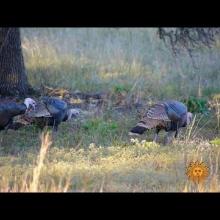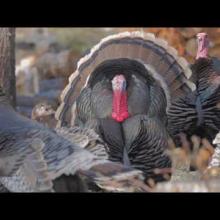

Join BirdNote tomorrow, November 30th!
Illustrator David Sibley and actor H. Jon Benjamin will face off in the bird illustration battle of the century during BirdNote's Year-end Celebration and Auction!
The anatomical structure we call the wishbone was long thought unique to birds. But fossil discoveries of recent decades have shown that some dinosaurs, including the mighty Tyrannosaurus rex, and the Velociraptors of ”Jurassic Park,” also had wishbones. And there is now wide consensus among experts that this group of dinosaurs includes the direct ancestors of modern birds. Not only did they have wishbones but, like birds, they likely incubated their eggs, had hollow bones, and were clad in feathers!
BirdNote®
The Thanksgiving Wishbone — and Dinosaurs
Written by Bob Sundstrom
This is BirdNote.
At Thanksgiving, when two people face off to break the turkey’s wishbone in two, they are reenacting an ancient ritual. The origin of the practice dates back more than 2000 years, to ancient Etruscans and Romans who attributed wish-giving powers to the dried wishbone of a chicken.
But if you think that is old, consider how far back the wishbone itself goes. [Music]
The anatomical structure we call the wishbone in birds is formed by the fusion of the two clavicles — what we call our collarbones. This anatomical structure was long thought unique to birds. But fossil discoveries of recent decades have shown that some kinds of dinosaurs also had wishbones. In particular, those dinosaurs known as theropods: carnivorous dinosaurs that stood upright and walked — and ran — on two legs. This group includes mighty Tyrannosaurus rex, and the terrifying Velociraptors of ”Jurassic Park.” [Music]
This means the wishbone itself dates back more than 150 million years.
And there is now wide consensus among experts that this group of dinosaurs in-cludes the direct ancestors of modern birds. (Not only did they have wishbones but, like birds, they likely incubated their eggs, had hollow bones, and were clad in feathers.)
So the next time you pull on a wishbone, think back to the Romans – and then way back to T. rex.
###
Bird sounds provided by The Macaulay Library of Natural Sounds at the Cornell Lab of Ornithology, Itha-ca, New York.
'Hatching Baby Raptor' composed by John Williams, from Jurassic Park - The Original Motion Picture Soundtrack, 20th Anniversary Edition, 2013 Geffen Records
'Ma Vlast (My Country): Vltava (The Moldau): Beginning' performed by Boston Symphony Orchestra and Rafael Kubelik, From 'Classical Masterpieces 1' Deutsche Grammophon
BirdNote’s theme music was composed and played by Nancy Rumbel and John Kessler.
Producer: John Kessler
Executive Producer: Dominic Black
© 2015 Tune In to Nature.org November 2014/2015/2020 Narrator: Michael Stein
ID# wishbone-01-2014-11-27







